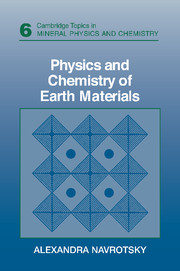Book contents
- Frontmatter
- Contents
- Acknowledgments
- 1 Introduction
- 2 Crystal chemistry
- 3 Experimental methods for studying structure
- 4 Methods for studying thermodynamic properties
- 5 Chemical bonding
- 6 Mineral thermodynamics
- 7 Solid solutions and order–disorder
- 8 Melts, glasses, and amorphous materials
- 9 The interface between mineral physics and materials science
- Index
4 - Methods for studying thermodynamic properties
Published online by Cambridge University Press: 05 June 2012
- Frontmatter
- Contents
- Acknowledgments
- 1 Introduction
- 2 Crystal chemistry
- 3 Experimental methods for studying structure
- 4 Methods for studying thermodynamic properties
- 5 Chemical bonding
- 6 Mineral thermodynamics
- 7 Solid solutions and order–disorder
- 8 Melts, glasses, and amorphous materials
- 9 The interface between mineral physics and materials science
- Index
Summary
Thermochemistry
The thermodynamics of mineral reactions can be studied by a variety of approaches. Because minerals are structurally complex and their stability and phase relations are governed by a delicate balance of energetic, entropic, and volumetric factors that depend on temperature, pressure, and composition, such work must pay careful attention to sample characterization. One must be concerned with sample purity (single phase, stoichiometric, unzoned material), structural state (order–disorder, polymorphism), careful experimental technique, and equilibrium (or lack of it) in the experiments. In analyzing the data, one must make the punishment fit the crime by using thermodynamic models that are appropriate to the processes involved, especially when the possibility of order–disorder exists. These models must be complex enough to incorporate the essential physics and chemistry and yet simple enough to apply to data frequently of limited extent and accuracy. It is essential to avoid too many fitting parameters – with enough parameters you can fit an elephant, but not grasp its essential nature. Thus although mineral thermodynamics might be regarded as a sub-branch of solid-state physics, the complexity of the structures and inherent messiness of natural systems, as well as the difficulty with which definitive experiments can be made gives this field its own flavor. In this chapter, experimental approaches are summarized. Chapter 6 and 7 deal with the systematics of mineral thermodynamics, especially linking macroscopic thermodynamics and physical properties to microscopic descriptions of structure and bonding.
- Type
- Chapter
- Information
- Physics and Chemistry of Earth Materials , pp. 148 - 171Publisher: Cambridge University PressPrint publication year: 1994

